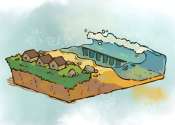Alcyonaria
Alcyonacea
Helioporacea
Zoantharia
Antipatharia
Corallimorpharia
Scleractinia
Zoanthidea
See Anthozoa for details
Corals are marine organisms from the class Anthozoa and exist as small sea anemone-like polyps, typically in colonies of many identical individuals. The group includes the important reef builders that are found in tropical oceans, which secrete calcium carbonate to form a hard skeleton.
A coral "head", commonly perceived to be a single organism, is formed from myriads of individual but genetically identical polyps, each polyp only a few millimeters in diameter. Over thousands of generations, the polyps lay down a skeleton that is characteristic of their species. An individual head of coral grows by asexual reproduction of the individual polyps. Corals also breed sexually by spawning, with corals of the same species releasing gametes simultaneously over a period of one to several nights around a full moon.
Although corals can catch small fish and animals such as plankton using stinging cells on their tentacles, these animals obtain most of their nutrients from photosynthetic unicellular algae called zooxanthellae. Consequently, most corals depend on sunlight and grow in clear and shallow water, typically at depths shallower than 60 m (200 ft). These corals can be major contributors to the physical structure of the coral reefs that develop in tropical and subtropical waters, such as the enormous Great Barrier Reef off the coast of Queensland, Australia. Other corals do not have associated algae and can live in much deeper water, with the cold-water genus Lophelia surviving as deep as 3000 m. Examples of these can be found living on the Darwin Mounds located north-west of Cape Wrath, Scotland. Corals have also been found off the coast of Washington State and the Aleutian Islands in Alaska.
Corals coordinate behaviour by communicating with each other.









